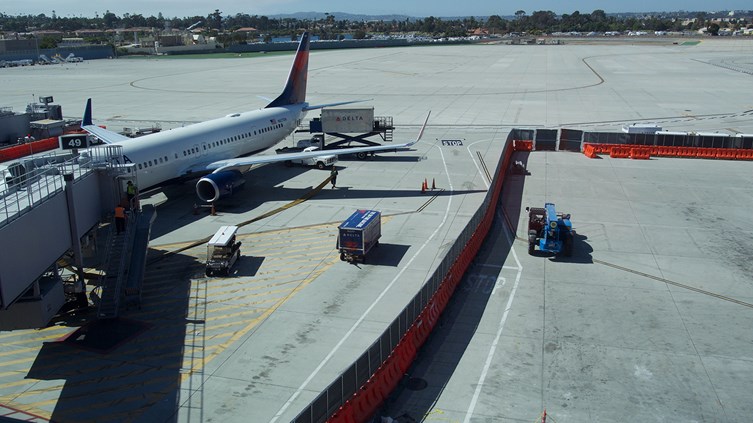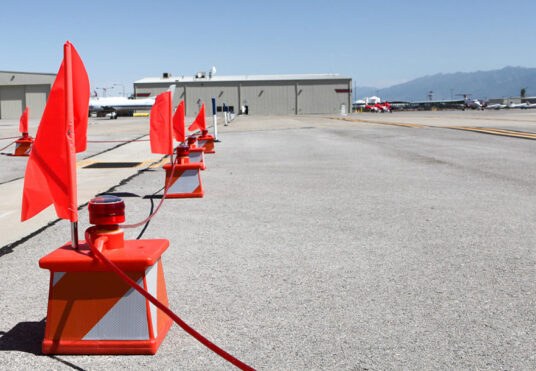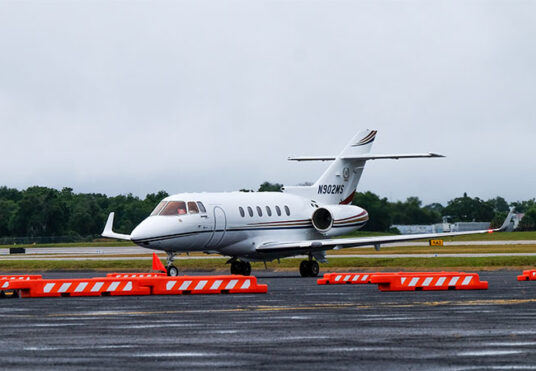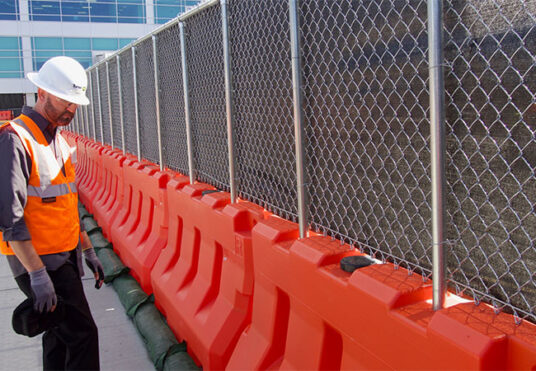Understanding Airport Barricade Regulations As a Contractor

When you’re a contractor on a project that involves working near active aircraft, it’s your responsibility to understand airport barricade regulations. Airport safety barricades are essential to mark off areas that are closed to flight operations. Within the areas under the authority of air traffic control (ATC), airport low profile barricades are generally required to meet the requirements of the Federal Aviation Administration (FAA) and to prevent damage to aircraft which may be operating near your work areas.
Understanding the Areas of a Working Airport
The entire air operations area (AOA) of a working airport, including aircraft parking areas, terminals, and the like are strictly regulated by the airport operator, who must answer to the FAA if any deviations from safe operating practices occur. The AOA is divided into non-movement areas and movement areas. Vehicles and aircraft routinely operate in the non-movement areas without specific instructions from ATC, provided they are permitted by the airport operator. As a contractor, you will typically be allowed to operate vehicles in these areas as needed to perform your work.
The movement area, by contrast, is under the control of ATC. This includes the runways and taxiways. You probably know that aircraft taking off, in flight, or landing are required to receive clearances from ATC, but it may be less obvious that if you enter a movement area you have the same responsibility. Contractors must be escorted into or across these areas by Follow-Me vehicles or other personnel who can communicate with ATC on a real-time basis. It’s the ATC’s responsibility to authorize these movements only when doing so will not create a risk of collisions.
There is one more region to think about within the movement area: the runway safety area. This area is determined by the scale of the runway itself, but for most runways designed for airliners, the runway safety area is around 250 feet on either side and 1,000 feet on each end. It’s critical that this area is kept clear of obstructions and high barriers. If the aircraft departs the pavement for any reason, such as a mechanical failure, risks to the aircraft and its occupants are greatly minimized if the runway safety area is clear, level, and free of obstructions.
This has a major impact on contracting work near the runway because personnel and their equipment must stay out of this safety area at all times when the runway is active. This is true even if part of the taxiway or grass areas outside of this area is being worked on. Airport safety barricades keep workers from straying into these areas without realizing where they are.
The Importance of Airport Safety Barricades for Closed Movement Areas
When you’re performing contracting work in or around a movement area, the airport must of course temporarily close these runways and taxiways so that you can work. Since it’s very difficult for contractor personnel to understand where these boundaries lie, airport barricade regulations require that you clearly distinguish open areas from closed areas. Airport safety barricades also allow pilots to see the areas which are closed.
Serious incidents and accidents have occurred because of collisions between aircraft, pedestrians, and contractor vehicles in active movement areas. The risk of serious property damage, injury, or loss of life must be avoided by the use of airport safety barricades. Since propellers and jet engines are generally mounted very close to the ground, the maximum height of airport low profile barricades is strictly defined. These barricades must be secured to avoid being picked up or moved by airflow created by engines or aircraft movement. Foreign object damage (FOD) is also a serious risk because jet engines can easily ingest items including loose bolts, tools, and equipment.
FAA Regulations for Airport Low Profile Barricades
Due to these requirements, the FAA has specific regulations for airport low profile barricades:
- Barricades and barricade hazard flags must be resistant to jet blast.
- Barricades must be UV resistant.
- Barricades must interlock to minimize FOD risk.
- Barricade hazard lights must be flashing or steady red, and visible from all directions.
While airport safety barricades can be weighted down and secured in a number of ways, an ideal barricade system can be filled with water once put in place. The water is harmless when it needs to be drained, and barricades can once again easily be moved to new locations when the worksite moves on to a new area. It’s also important to note that plans will call for red flashing or steady burn hazard warning lights. Yellow lights for barricades have not been approved by the FAA since the early 2000s because they can easily be confused for runway intersection markers.
Be careful when reading plans for airport projects that you may be asked to bid on because some airports do not conform to these regulations and may say in their own specifications that you can use barrels, sawhorses, railroad ties, or even jersey barriers made of concrete during your project. These types of barricades do not meet airport barricade regulations and are unsafe. They could cause damage to aircraft, personal injuries, or even death. You could be held liable for damages or have a tragedy on your conscience.
By being aware of these regulations, you can maintain the proper environment on your project. Airport low profile barricades are required whenever aircraft might be operating in close proximity to your work area, such as a worksite near the runway safety area. OTW Safety is knowledgeable and experienced in airport barricades and can help you meet the requirements for your upcoming job. Contact us today!


